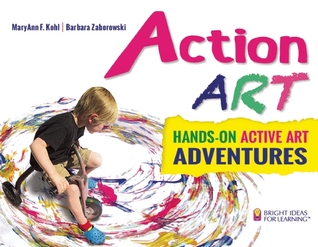An intersection of physical science and art
By Peggy Ashbrook
Posted on 2015-08-27
I love it when a book of art activities recommends finding materials in thrift stores or using recyclables or common classroom materials to create art. It’s even better when the activities can be part of a science exploration or investigation into science concepts such as the properties of matter, or the motion of objects. Action Art: Hands-on active art adventures  by MaryAnn F. Kohl and Barbara Zaborowski is such a book and I look forward to school opening so I can involve the children in painting on fabric, tearing the fabric when dry, and weaving pieces into a new object—the process is described in the activity “Runaway Sheets.”
by MaryAnn F. Kohl and Barbara Zaborowski is such a book and I look forward to school opening so I can involve the children in painting on fabric, tearing the fabric when dry, and weaving pieces into a new object—the process is described in the activity “Runaway Sheets.”
What science concepts can be explored in this activity, or more importantly, what science investigation or engineering design work will be extended by including this activity as another way for children to engage with a science concept or an engineering design process? Here are a few ideas:
|
Science Properties of liquids (paints): Consistency, flow, shape of drops Absorption—of liquids by fabric Force—strength and direction of a pull to tear the fabric
|
Engineering Systems—for painting, for effective tearing the cloth into strips How to combine pieces to create a whole new object Constraints—limited amount of material, and the properties of the material |
 I like how children and their adults can return to a piece of artwork and continue developing it with additional materials as they reflect on the action and materials that created it. I’ll be thinking about how the Practices of Science and Engineering are involved in these activities:
I like how children and their adults can return to a piece of artwork and continue developing it with additional materials as they reflect on the action and materials that created it. I’ll be thinking about how the Practices of Science and Engineering are involved in these activities:
1. Asking questions (for science) and defining problems (for engineering) 2. Developing and using models 3. Planning and carrying out investigations 4. Analyzing and interpreting data 5. Using mathematics and computational thinking 6. Constructing explanations (for science) and designing solutions (for engineering) 7. Engaging in argument from evidence 8. Obtaining, evaluating, and communicating information
My students have been actively involved in art experiences before but with this resource we will be even more engaged!
Disclaimer: The views expressed in this blog post are those of the author(s) and do not necessarily reflect the official position of the National Science Teaching Association (NSTA).


